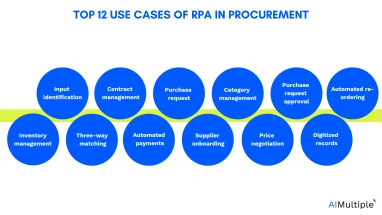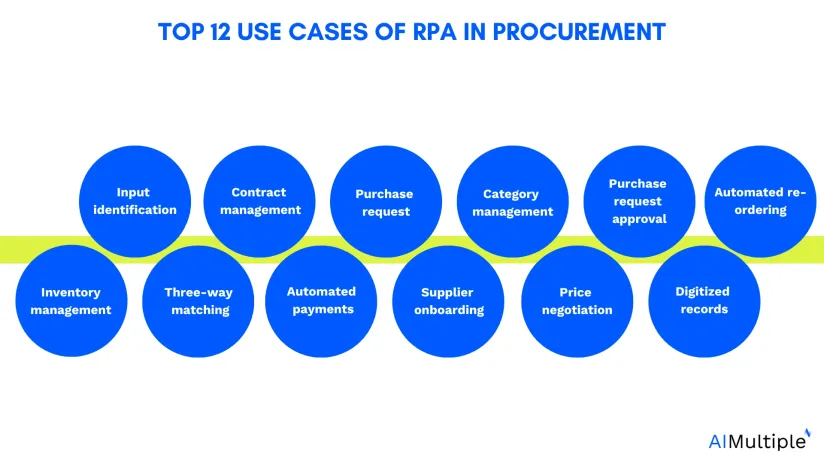Chief procurement officers (CPOs) are pessimistic about the supply chain volatility index of 2024 pointing a huge and increasing volatility in 2024.1 A remedy is a more robust procurement process that keeps the business ahead of the market and geopolitical dynamics. Robotic process automation (RPA) can assist the procurement department in managing their procurement tasks better.
Businesses face procurement process challenges may also get help from procurement software. See the top 12 use cases of RPA in procurement such as contract management and automated payment processing:
Top 12 use cases of RPA in procurement
1. Input identification
RPA’s first procurement application is input identification. RPA can retrieve each product’s input list from the bill of materials (BOM) and store it in a hub.
Periodic, constant, and accurate access to the company’s input list increases the speed at which the procurement team starts the purchasing process. The other benefit is improved supply planning as the procurement team stays on top of what is needed to be purchased, and sends the purchase request in advance.
2. Contract management
Robotic process automation can automate contract management. Use cases would include:
- Drafting B2B contracts by automatically extracting the vendors’ info and putting it on the draft
- Sending notification to the procurement teams whenever a contract is reaching the expiry date
- Archiving each contract in each vendor’s dedicated database
- Using Optical Character Recognition (OCR) and Natural Language Processing (NLP) to review contracts and ensure the SLA terms comply against company policy
3. Purchase request & purchase order submission
Purchase requests and purchase orders are submitted to inform the company’s decision-makers and the vendor of the type and quantity of the needed items.
Instead of manually submitting these requests, the procurement team can fill out digital templates. Same as sending an email, the request will then be sent to the department heads, to then be forwarded to the vendors after approval.
4. Category management
Different departments are in charge of purchasing their own materials. RPA, intelligent automation, and ML tools can identify and assign each product’s category with the correct procurement department and tag them. RPA also reminds procurement staff to approve delivery notices or reschedule production in case of delayed shipments.
5. Purchase request approval
RPA in procurement is useful because it can automatically approve routine purchase requests by referring to business rule engines. For example, machine learning algorithm would identify the reorders for commonly used items.
The data can then be structured. RPA bots will then place reorders. So as long as the orders meet the procurement strategy, orders for current needs can be approved without human involvement.
And if the order is an exception and needs human intelligence for assessment, the request can be forwarded to the procurement manager for final approval.
6. Automated re-ordering
RPA in procurement can monitor the inventory levels on the dashboard and automatically create purchase orders for the reordering products. One of the benefits of automated re-orders is a consistent manufacturing process because the vital intermediary goods will always be in-time for the production cycle.
Automated re-orders would help bypass the need for a human to keep monitoring the inventory levels and fill out purchase orders electronically or otherwise. This ensures that the future needs of the company are tended to.
7. Inventory management
Robotic process automation (RPA) and IoT integration enables digital monitoring of inventory levels. This feature allows RPA to create automated reports and inventory audits.
Some businesses, such as restaurants, need to not overload their inventory of perishable produce. So it’s important to have a real-time Especially for businesses that rely on fresh inventory levels, such as restaurants that overload on perishable stuff, it’s important to have a real-time report of what exactly you have right now.
Automating inventory management also means products that stay in the warehouse longer can be recognized and purchased less, enabling smart procurement.
8. Three-way matching
Another use case of RPA in procurement is automated three-way matching. The RPA bots can automatically compare purchase requests, with the supplier invoices, and the delivery receipt to confirm that the ordered products are those which should’ve been ordered. Three-way matching also ensures that the goods have been delivered.
9. Automated payments
RPA bots can be scheduled to make automated payments after schedule triggers. On-time payments improve supplier relationship management and uphold the business reputation. Moreover, finance APIs allow ROA bots to make payments to the correct vendor in the right amount. That’s because they would exchange the information between the suppliers’ list and the AP automation solution.
This reduces the workload of the procurement teams and makes correct, timely payments. Procurement software is another helpful tool for decreasing the workload of procurement departments.
10. Supplier onboarding
Same as with employee onboarding, companies can leverage RPA to automate parts of their supplier onboarding. For instance, RPA bots can extract vital information from the suppliers’ websites (such as their references, prices, etc.) and put it in a report.
Moreover, RPA in procurement also means that bots can asses the suppliers through rule-based decisions. For instance, if a company wants to hire an event planner with experience in the pharmaceutical industry, and there are no case studies of that on the vendor’s website or attached to their profile, they can be ranked lowest.
These preliminary assessments can be time-consuming. By having robots completing these tasks, the employees can spend their time on higher value work.
11. Price negotiation
After receiving a vendor quote, companies can use RPA bots to automatically negotiate prices through a rules-based framework. So when it comes to approving/rejecting/negotiating a quote, intelligent automation-enabled RPA bots can compare the quoted price against the established threshold. Then following the conditional result (i.e., “if price is X% higher than Y, do Z”) the bots can send their rebuttal.
12. Digitized records
After making a payment, robotic process automation bots can automatically create a journal entry. This will assist in book-keeping and close-season balance sheet reconciliation. That’s because all the entries will be made in real-time. Moreover, the efficiency of auditing also improves, as the digital footprint will allow one-click access to large volumes of data.
For more on RPA
To learn more about RPA and its use cases, read:
And if you’re ready to invest, you may check a data-driven list of RPA vendors.
We can help you in select the best RPA vendor according your needs:




Comments
Your email address will not be published. All fields are required.